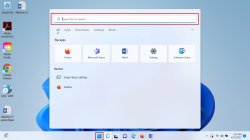Windows 11 is the latest upgrade to Microsoft Windows that has replaced Windows 10. The biggest change is the new design and interface but there are many other enhancements with Windows 11:
- New Design
- Changed Taskbar
- Redesigned Settings App
- Overhauled Start Menu
- New Window Snap Layouts
- Virtual Desktops
New Design
Windows 11 features a new design with a centered Start menu and Taskbar. It features a clean design with rounded corners and pastel shades.

The Taskbar
All the icons are now centered on the taskbar, instead of lined up from left to right. The Start button is now the leftmost icon on the centered taskbar.

To personalize the Taskbar, right-click on the Taskbar and choose Taskbar settings.

System Tray
The System Tray has been modified in Windows 11. The Action Center has been split into two separate flyouts: one for notifications and the other for quick settings.

The Start Menu

The Start menu no longer includes live tiles (square icons). Instead, the Start menu shows three rows of icons along its top half (Pinned), with icons for frequently used apps on the bottom half (Recommended).

- To pin an app to the Taskbar, right-click on the app and select Pin to taskbar.

- Select All apps for a full listing of apps.

- To add an app to the Pinned section of the Start menu, right-click on the app and select Pin to Start.

Search Bar
You can search for a specific app, file, setting, etc. using the Search tool. Select Search in the Taskbar.

Redesigned Settings App
Although Control Panel is still available, Windows 11 includes a new Settings app with a bunch of improvements and new settings. To navigate to Settings, select the Start menu and click on Settings.

Snap Layouts
Windows 11 comes with Snap assist, a feature that makes it easy to organize your windows on the desktop. These snap layouts pop up when you hover your cursor over the Maximize/Restore button and give options between four layouts for up to four windows.

Virtual Desktops
Virtual desktops are used to create a separate desktop so that you could have one desktop for one project and a second for another. In Windows 11, you can now have a different wallpaper for each desktop, making it easier to distinguish one from another.
Creating a Virtual Desktop
- Hover over or click on the Task view icon in the taskbar.

- Select the New desktop thumbnail.
Changing the Background of a Desktop
Select the virtual desktop, right-click a blank spot on the desktop, select Personalize in the menu and select Background.

Shutting Down Windows 11
Select the Start menu, select the Power button and choose from the provided options.

